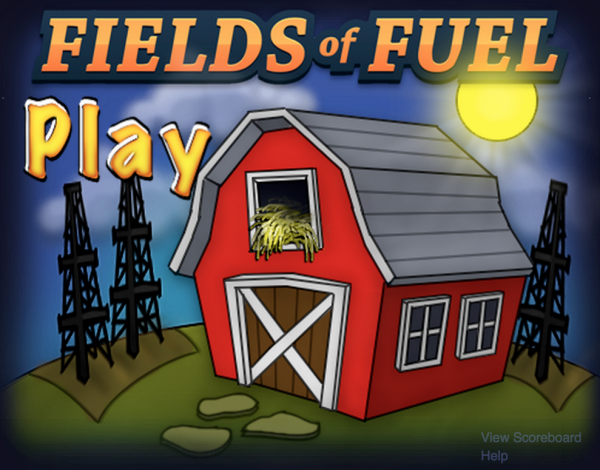
Fostering sustainability is no game, but having a little fun helps high school students understand the complex concepts — like multivariable regression (i.e., lots of causes can impact lots of outcomes) — that go into biofuels production.
Fields of Fuel, a game released in the fall by the Great Lakes Bioenergy Research Center Education and Outreach team, in collaboration with computer scientists at the Wisconsin Institute for Discovery, education faculty, and classroom educators, is doing just that. According to a study by the game’s creators published in a recent issue of the journal “The Science Teacher,” high school students playing Fields of Fuel as a team or against each other found it fun, informative and a good spark for discussions on sustainability. Better still, the students sharpened negotiating and reasoning skills that serve them well no matter the topic of discussion.
To help us get a feel for Fields of Fuel, we logged some joystick time and describe what players take away from the experience. Here’s our report:
The last fun educational video game I remember playing was Lemonade Stand on an Apple IIe in Mr. Baleno’s sixth grade class. In 1991.
In that game, the player could pick how much to spend on supplies and how much to charge per glass of lemonade, then HOPE FOR SUN. If all worked out, you sold a ton of lemonade and made 9.0000 x 10^17 dollars.
Since then, educational games have gotten, well, smarter.
Take Fields of Fuel. The purpose is to introduce concepts of bioenergy (i.e. that we can grow things then turn them into fuel) to high school students.
Since I’m only 20 years removed from high school myself (oy vey!), I decided to give it a whirl.
Beginners are encouraged to start the game in single player mode without computer simulated competition, but I’m determined to beat the machines, so automated bot Farmer Steve – named after post-doctoral researcher Steve Wangen, a member of computer science professor Michael Ferris’s team who worked on the game – and three of his virtual neighbors are born.
A quick game play walk-through, and we’re off. Measures of success are broken down into three categories: how much cash I make, how much fuel I produce, and how my farm’s environment is doing.
I’ve decided to focus on one thing for my four fields of crops: BENEFICIAL BUGS, one component of the environmental score that I’ll measure later. These are the little pollinators and predators that keep the flowers blooming and pests like aphids from eating my crops.
Next, I get to plant my fields: alfalfa, corn, or switchgrass. I decide to start out with one of each plus a bonus field of switchgrass, which the game tells me is good for energy, neutral for the environment, and not necessarily amazing for my bottom line.
Then, I get to choose whether I want to till and fertilize my soil. Both can improve crop yields in the short term but can rob the soil of nutrients over time. My plan: au natural! No till, no fertilizer. Let the crops fall where they may, I say.
After one round, it’s nice to see little graphs of statistics accrue on the right side of my screen. So how am I doing? Well, let’s just say I’m still learning. But I’m in first place in the environmental category – eat it farmer Steve!
But it’s time to plant for next year.
But first: how are my bugs doing? After starting out at “0%”, I’m now just over 50% for each of my fields. Great! Also, while I notice water quality has decreased, the corn and alfalfa fields made me money.
MORE ALFALFA!
Five seasons go by of planting, and I experiment with various mixes – and when I’m feeling really crazy, four fields of switchgrass. I’m rewarded with first place in one major category: environmental score; and last across the board in energy production, sustainability and economy.
The machines have won. This time.
Still, there were moral victories. First: trying to beat robot farmers at their own game is fun; second: I learned a thing or two, namely that there are a lot of factors that go into farming, and each decision has real implications.
Plus, adding the components of bioenergy output and environmental outcomes to a simulated farming experiment demonstrates how they can all be connected. Once a few rounds go by, it’s pretty easy to tell what factors go into building quality in each category, so inputs can be tailored to outputs.
And students who’ve played the game are grasping how these factors fit together.
Leith Nye, Great Lakes Bioenergy Research Center Education and Outreach Coordinator and co-author of the Science Teacher study, notes that students who have played the game saw significant learning gains in terms of understanding concepts related to sustainability.
“In particular,” Nye says, “they were able to explore and explain some of the cause and effect mechanisms within each particular system within the game.”
Want more biofuel? Plant more corn. Want to have better water quality? Compare crops and management practices to the water quality after each season. Want more beneficial bugs? Well, I haven’t figured that out, yet, but a few more rounds should do the trick.
Fields of Fuel also conveys the fact that these multitude farming factors are measurable from year-to year, providing benchmarks on how to decide what outcomes are important to individuals. This means that there’s a huge capacity in basic models of biofuel production for both analysis of the past and mindfulness towards the future.
With new information in hand, next time I’ll be able to take it to bot Farmer Steve and hopefully score one small victory for humankind. Alternatively, I could play against actual humans.